

| Home Page | Overview | Site Map | Index | Appendix | Illustration | About | Contact | Update | FAQ |
 |
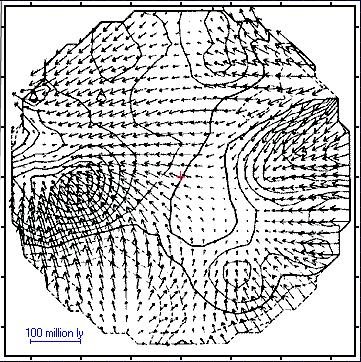 |
of the major galaxy superclusters that surround the Virgo supercluster. These superclusters are not isolated in space but together with many other smaller concentrations of galaxies, they form parts of extensive walls of galaxies surrounding large voids. Three of the biggest walls as well as several of the largest voids are marked on the map. The Virgo along with the Hydra and other superclusters are streaming at a speed of 6x107 cm/sec toward the "Great Attractor" (Figure 03-02b, 2-D plot on galactic plane with Milky Way at the center, arrows show the directions and magnitude of the motion), which is a gigantic unseen mass located near the A3627 (Norma) cluster (Figure 03-02c) in the Centaurus Wall near the galactic plane. In comparison, the speed of |
Figure 03-02a Large Scale Structures |
Figure 03-02b Attractor A3627 |
cosmic expansion is about 7x108 cm/sec at a distance of 100 megapc. (See " Laniakea Supercluster" for news on attractor") |
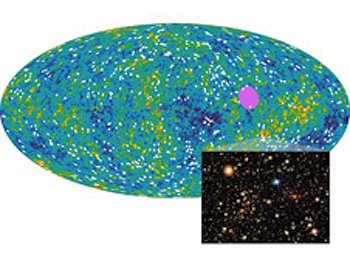 |
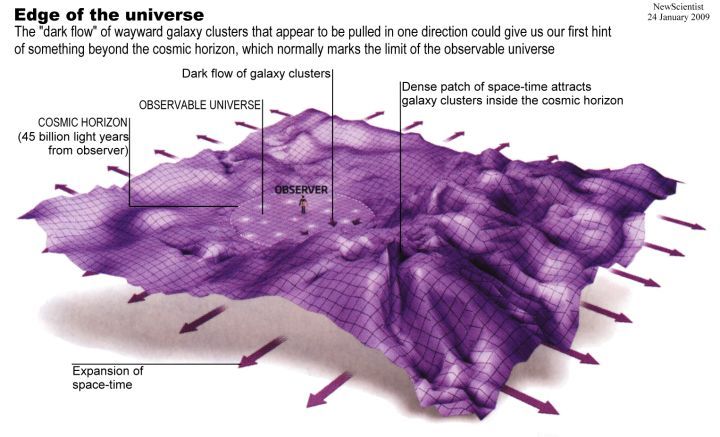 |
patch of sky near A3627 in the direction between the constellations of Centaurus and Vela (the pink area in Figure 03-02e, also see Figure 03-02c). The clusters show a small but measurable velocity that is independent of the universe's expansion and does not change as distances increase. It is suggested that such motion (now called darkflow) is caused by the gravitational attraction of matter that lies beyond the observable universe (Figure 03-02f). Insert in Figure 03-02e shows one of such clusters 1E 0657-56. |
Figure 03-02eUnobser -vable Attractor |
Figure 03-02f Darkflow |
See "Laniakea Supercluster" for the 2014 research on the Great Attractor. |

 c = 2.82x10-13 cm, where
c = 2.82x10-13 cm, where  c = (
c = ( /mc) = 0.363x10-10 cm is the reduced Compton wavelength, which is actually the de Broglie wavelength for the electron moving with moment p = 2
/mc) = 0.363x10-10 cm is the reduced Compton wavelength, which is actually the de Broglie wavelength for the electron moving with moment p = 2 mc.
mc. c/
c/ = 5.3x10-9 cm.
= 5.3x10-9 cm. 2mc2/2 = -2.17x10-11 erg = -13.6 ev.
2mc2/2 = -2.17x10-11 erg = -13.6 ev. (
( )/d
)/d = (
= (
 c)2(1 + cos2
c)2(1 + cos2 )/2.
)/2. )n, where n = 1, 2, 3, ... , appears in the S-matrix of all the quantum electromagnetic processes. It is related to the probability of the occurrence of each one. This is actually the consequence of adopting the perturbation expansion for QED.
)n, where n = 1, 2, 3, ... , appears in the S-matrix of all the quantum electromagnetic processes. It is related to the probability of the occurrence of each one. This is actually the consequence of adopting the perturbation expansion for QED.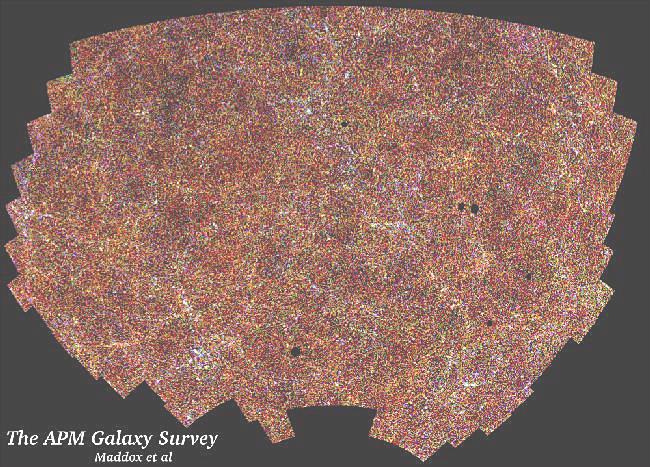 |
Figure 03-03 presents a different view of the large scale structure, which covers a region of sky about 100o by 50o around the South Galactic Pole. The APM (Automatic Plate Measuring) Galaxy Survey contains positions, magnitudes, sizes and shapes for about 3 million galaxies. The picture shows the galaxy distribution as a density map on the sky. Each pixel covers a small patch of sky 0.1o on a side, and is shaded according to the number of galaxies within the area: where there are more galaxies, the pixels are brighter. Galaxy clusters, containing hundreds of galaxies closely packed together, are seen as small bright patches. The larger elongated bright areas are superclusters and filaments. |
Figure 03-03 APM Galaxy Survey |
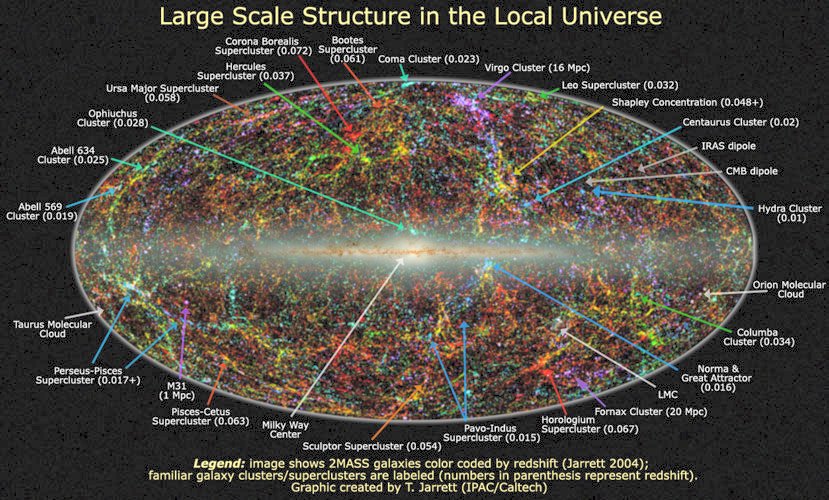 |
each pixel: fainter galaxies are shown as red, intermediate are shown as green and bright are show as blue. The more distant galaxies tend to be fainter, and also show less clustering, and so the maps has a generally uniform reddish background. The more nearby galaxies tend to be bright, and are more clustered, so the more prominent clusters of galaxies in the map tend to show up as blue. The small empty patches in the map are regions that have been excluded around bright stars, nearby dwarf galaxies, and globular clusters. Figure 03-04a shows an all sky distribution produced by the Two Micron All Sky Survey (2MASS) with more than one million galaxies and similar color codes (as the APM). The Milky Way is at the center of the map. |
Figure 03-04a Galaxy Survey, 2MASS [view large image] |
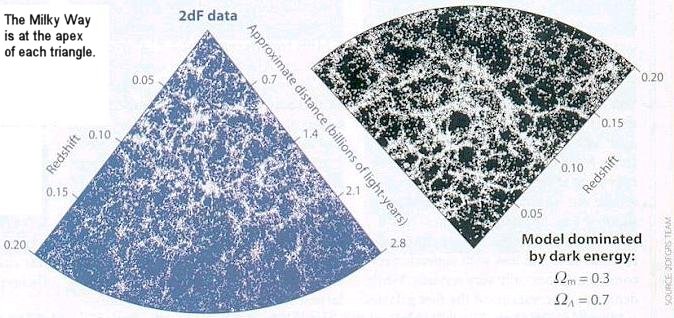 |
The 2dF Galaxy Redshift Survey (completed in 2002) provides yet another view of the large-scale structure as shown in Figure 03-04b. It used the 3.9 meter Anglo-Australian Telescope to obtain spectra for nearly a quarter million galaxies up to redshift of 0.20. The pattern is remarkably similar to the computer simulation assuming the WMAP dark matter and dark energy composition of 30% and 70% respectively. |
Figure 03-04b 2dF Galaxy Survey |


